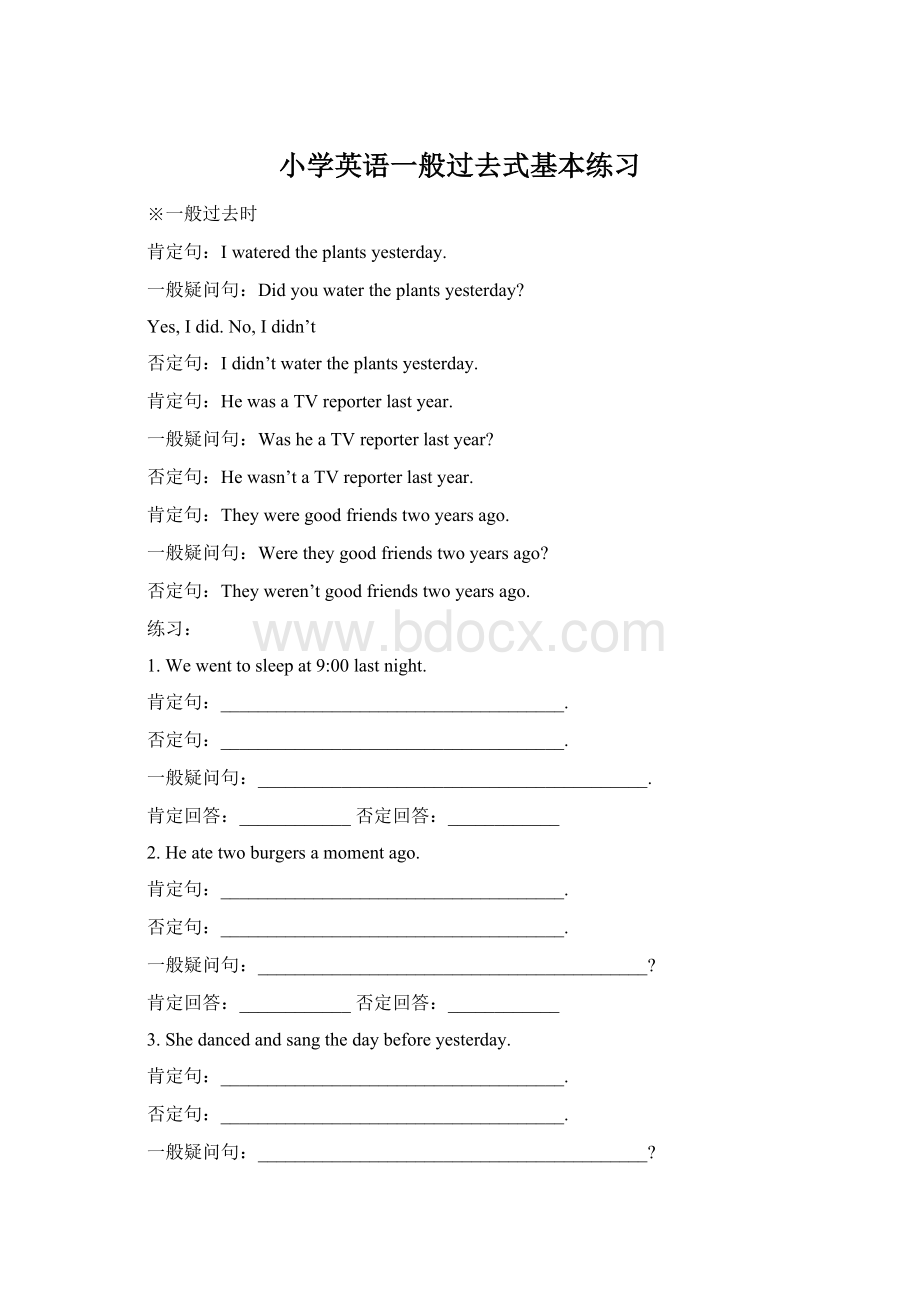小学英语一般过去式基本练习.docx
《小学英语一般过去式基本练习.docx》由会员分享,可在线阅读,更多相关《小学英语一般过去式基本练习.docx(22页珍藏版)》请在冰豆网上搜索。

小学英语一般过去式基本练习
※一般过去时
肯定句:
Iwateredtheplantsyesterday.
一般疑问句:
Didyouwatertheplantsyesterday?
Yes,Idid.No,Ididn’t
否定句:
Ididn’twatertheplantsyesterday.
肯定句:
HewasaTVreporterlastyear.
一般疑问句:
WasheaTVreporterlastyear?
否定句:
Hewasn’taTVreporterlastyear.
肯定句:
Theyweregoodfriendstwoyearsago.
一般疑问句:
Weretheygoodfriendstwoyearsago?
否定句:
Theyweren’tgoodfriendstwoyearsago.
练习:
1.Wewenttosleepat9:
00lastnight.
肯定句:
_____________________________________.
否定句:
_____________________________________.
一般疑问句:
__________________________________________.
肯定回答:
____________否定回答:
____________
2.Heatetwoburgersamomentago.
肯定句:
_____________________________________.
否定句:
_____________________________________.
一般疑问句:
__________________________________________?
肯定回答:
____________否定回答:
____________
3.Shedancedandsangthedaybeforeyesterday.
肯定句:
_____________________________________.
否定句:
_____________________________________.
一般疑问句:
__________________________________________?
肯定回答:
____________否定回答:
____________
4.Iwasabadboyseveralyearsago.
肯定句:
_____________________________________.
否定句:
_____________________________________.
一般疑问句:
__________________________________________?
肯定回答:
____________否定回答:
____________
5.Theywereverylovelyin2001.
肯定句:
_____________________________________.
否定句:
_____________________________________.
一般疑问句:
__________________________________________?
肯定回答:
____________否定回答:
____________
I________(like)EnglishwhenIwasachild.NowI______________
(study)Chineseinaschool.Ioften_______(go)backhomeonfootintheevening.ButthreedaysagoI________(fly)home.It______(be)
veryinteresting.IthinkI____________(become)abirdinfuture.
※(基数词,序数词,动词,介词)
一、基数词,序数词
序数词前一定要加“the”,序数词一般用于:
①日期【the号(序数词)of月】②【第几…】③【名次】
二、动词
1. be动词(am/is/are)
主语
be动词(原形)
be动词(过去式)
I
am
was
He/she/it
is
was
We/you/they
are
were
2.助动词(do/does/did)
问句
答句
Do+非第三人称单数
+动词原形…?
…do/don’t
Does+第三人称单数
…does/doesn’t
Did+所有主格
…did/didn’t
问句
答句
Whatdoyou/they/we…
+动词原形?
I/They/We+动词原形…。
Whatdoeshe/she/it…
He/She/It+(动词+S)….
Whatdidyou/they/we/he/she/it…
I/They/We/He/She/It+动词过去式。
3.情态动词(can,must,could,would,may,shall,would)
情态动词后面都跟动词原形
三、介词
①in+月、年themorning/afternoon/evening/aweek
表示时间②on+具体某一天(几月几日)/某个假期(…Day)
③at+具体某点时间、某个假期(…Festival)/theweekend
①in…street
表示方位②on…road/left/right
③atthe…crossing/stop/某个具体的地点
①inthetree(不是树上长出来的)
②onthetree(树上原来自己长出来的)
表示时间:
①ago(……以前)later(……以后)
②before(在……以前)after(在……以后)
※名词,代词,形容词及副词的比较级
一、名词
1. 不可数名词:
bread,juice,tea,coffee,water,chocolate,rice,paper(不可数名词相对应的be动词永远都是is/was)
2、名词复数规则
(1).一般情况下,直接加-s,如:
book-books,bag-bags,cat-cats,bed-beds
(2).以s.x.sh.ch结尾,加-es,如:
bus-buses,box-boxes,brush-brushes,watch-watches
(3).以“辅音字母+y”结尾,变y为i,再加-es,如:
family-families,strawberry-strawberries
(4).以“f或fe”结尾,变f或fe为v,再加-es,如:
knife-knives
(5).不规则名词复数:
man---men,woman---women,policeman---policemen,policewoman---policewomen,mouse---micechild---childrenfoot---feet,.tooth---teethfish---fish,people---people,Chinese---Chinese,Japanese---Japanese
二、代词
主格
宾格
形容词性物主代词
名词性物主代词
非第三人称单数
I
me
my
mine
We
us
our
ours
you
you
your
yours
they
them
their
theirs
第三人称单数
he
him
his
his
she
her
her
hers
it
it
its
its
1. 主格一般用在句中作为主语,一般用在动词前(除疑问句)
2. 宾格多用于动词介词后面。
3. 形容词性物主代词后面必须要跟名词。
4. 名次性物主代词=形容词性物主代词+名词
三、 形容词及副词的比较级
1.形容词比较级用于两者比较,基本句式为:
(A)主格+be|+形容词比较级+than+B(宾格)。
2.副词比较级基本句式为:
(A)主格+动词|+副词比较级+than+B(宾格)。
3. 比较级的用法:
①一般+er
②双写最后一个字母+er,如thin—thinner,big—bigger,fat—fatter,hot—hotter,
③不规则的比较级:
good/well—better,many/much—more,far—farther/further
4. 一样的情况用as…as,句式为:
as原级as
5. 注意:
too,very+原级
(特殊疑问词)
七、特殊疑问词
单词
意思
用法
回答
when
什么时间
问时间
who
谁
问人
whose
谁的
问主人
where
在哪里
问地点
which
哪一个
问选择
why
为什么
问原因
what
什么
问东西
whattime
什么时间
问时间
whatcolour
什么颜色
问颜色
whatabout
…怎么样
问意见
whatday
星期几
问星期
whatdate
什么日期
问具体日期
whatfor
为何目的
问目的
how
…怎么样
问情况
howold
多大
问年龄
howmany
多少
问数量
howmuch
多少
问价钱
howabout
…怎么样
问意见
howfar
多远
问路程
※动词时态
1. 一般现在时(关键词:
often/usually/always/sometimes/every…/on(星期+s)
① 非第三人称单数(I、We、you、they)+动词原形
② 第三人称单数(He、she、it)+(动词+s)
2. 现在进行时(关键词:
now/look/listen)be+动词ing
主语
Be动词
动词
I
am
(动词+ing)
He/she/it
is
We/you/they
are
动词加ing的变化规则
(1).一般情况下,直接加ing,如:
cook-cooking
(2).以不发音的e结尾,去e加ing,如:
make-making,taste-tasting
(3).如果末尾是一个元音字母和一个辅音字母,双写末尾的辅音字母,再加ing,如:
run-running,stop-stopping
3. 一般过去时(关键词:
justnow,amomentago,yesterday,last…,yesterday…,thismorning,on/at…)
(1).Be动词在一般过去时中的变化:
⑴am和is在一般过去时中变为was。
(wasnot=wasn’t)
⑵are在一般过去时中变为were。
(werenot=weren’t)
⑶带有was或were的句子,其否定、疑问的变化和is,am,are一样,即否定句在was或were后加not,一般疑问句把was或were调到句首。
(2).句中没有be动词的一般过去时的句子
否定句:
didn’t+动词原形,如:
Jimdidn’tgohomeyesterday.
一般疑问句:
在句首加did,句子中的动词过去式变回原形。
如:
DidJimgohomeyesterday?
特殊疑问句:
⑴疑问词+did+主语+动词原形?
如:
WhatdidJimdoyesterday?
⑵疑问词当主语时:
疑问词+动词过去式?
如:
Whowenttohomeyesterday?
(3).动词过去式变化规则:
①.一般在动词末尾加-ed,如:
pull-pulled,cook-cooked
②.结尾是e加d,如:
taste-tasted
③.末尾只有一个元音字母和一个辅音字母的重读闭音节,应双写末尾的辅音字母,再加-ed,如:
stop-stopped
④.以“辅音字母+y”结尾的,变y为i,再加-ed,如:
study-studied
⑤.不规则动词过去式:
am,is---was,are-were,do---did,see---saw,say---said,give---gave,get---got,go----went,come---came,have---had,eat---ate,take----took,run---ran,sing---sang,put---put,make---made,read---read,write---wrote,draw---drew,drink---drank,fly---flew,ride---rode,speak---spoke,sweep----swept,swim----swam,sit----sat
4. 一般将来时(关键词:
tomorrow、nextday(week,month,year…)、soon、atonce、thisafternoon/evening/thedayaftertomorrow(后天)等)
1begoingtodo将要做某事
主语
Be动词
I
am
Goingto+动词原形
He/she/it
is
We/you/they
are
2 willdo将要做某事
时钟
分≤30分分past小时半个小时=30分=half
例子:
12:
20twentyminutepasttwelve
分﹥30分60-分to小时+1一刻=15分=aquarter
例子:
12:
31twentynineminutetothirteen
季节
Sping(3-5)
Summer(6-8)
Autumn(9—11)
Winter(12—2)
时间
March---may
June,---august
September---november
December---february
天气
Warmrainy
Hotsunny
Coolwindy
Coldsonwy
活动
gorowing/fishing
flykites
Goswimming
eatwatermelons
Gocamping,goonanouting,goclimbing
Makesnowmen,goskating/skiing,putonwarmclothes
春城:
昆明(kunming)冰城:
哈尔滨(harbing)日光成:
拉萨(lasa)
火炉:
广州(guangzhou)澳大利亚(Australia)季节正好和我们相反,白天黑夜也相反
※可数与不可数名词讲解
英语中的名词按其表示的事物性质的不同可分为可数名词与不可数名词。
这两种名词在用法上是有区别的,现归纳如下:
一、可数名词有单数、复数之分,如:
map→maps;onion→onions;baker→bakers
不可数名词没有复数形式,只有单数形式。
如:
somewater;alotofbread
二、单数可数名词表示泛指时,前面要用不定冠词a(an);而不可数名词不能用a(an)。
如:
LiHongisadriver.Iamateacher.李红是一名司机,我是一名教师。
Wecan’tseemilkonthetable.我们看不见桌上有牛奶。
[友情提醒]在表示特指时,不可数名词和可数名词前都要用定冠词the,如:
Passmetheball,please.请把球传给我。
Thechickenontheplateisyours.盘子里的鸡肉是你的。
三、可数名词表示复数意义时可用many等词修饰。
如:
manyapples;alotoftomatoes;afewpens
不可数名词则要用much、alittle等词修饰。
如:
muchmeatalittlebreadlittlewater
[友情提醒]这两类名词都可以被some、any、alotof(lostof)等修饰。
如:
someeggs/paper(纸)。
Alotof(lotsof)knives/orangejuice
四、可数名词前通常可用具体的数词来修饰。
如:
threewomen
tenbabies
不可数名词表示数量的多少时,必须与表示数量的名词连用,即“数词+表示数量的名词(可数名词)+of+不可数名词”。
如:
twoglassesofmilk两杯牛奶
fivepiecesofbread五片面包
五、可数名词作主语时,谓语动词的单、复数与主语的单、复数须保持一致。
不可数名词作主语时,谓语动词只能用单数形式。
如:
Thereissomericeinthebowl.碗里有些米饭。
Allthestudentsareintheclassroom.所有的学生都在教室里。
[友情提醒]如果不可数名词前有复数名词短语修饰时,谓语动词须用复数形式。
如:
Therearetwobagsofriceintheroom.房间里有两袋大米。
六、对可数名词的数量提问用howmany;对不可数名词的数量提问要用howmuch,但对不可数名词前表示数量名词中的修饰语提问时要用howmany。
如:
Icanseetwopicturesonthewall.→Howmanypicturescanyouseeonthewall?
Thereisalotofporkinthebasket.→Howmuchporkisthereinthebasket?
Iwantthreeglassesofwater.→Howmanyglassesofwaterdoyouwant?
七、另外,有些集合名词也是可数名词,但不同的是,它们以单数形式出现,表示复数概念,如people,police,family等;而有些可数名词本身就以复数形式出现,如clothes,glasses(眼镜)等;有的可数名词单、复数形式相同,如Japanese,sheep,Chinese等。
如:
TheChinesepeoplearehardworkingandbrave.中国人民勤劳勇敢。
Thesportsclothesarenew.这些运动服是新的。
Ihaveonesheep.Hehastwosheep.我有一只羊,他有两只羊。
(人教PEP)三年级英语下册Unit1-3单元复习题
一、找出下列各组中不属于同一类的单词,填序号。
(10分)
()1.A.watchB.computerC.uncleD.pen
()2.A.sisterBradioC.sonD.daughter
()3.A.planeB.bikeC.carD.window
()4.A.womanB.friendC.tallD.girl
()5.A.zebraB.tigerC.eggD.panda
()6.A.zooB.crayonC.storybookD.tape
()7.A.brotherB.staplerC.knifeD.copybook
()8.A.doorB.tapC.lightD.tape
()9.A.fatB.EnglishC.bigD.small
()10.A.telephoneB.sofaC.bookcaseD.T-shirt
二、选择填空(20分)
1.()MayIcomein?
A.Yes.B.Comein,pleaseC.Sure.
2.()Isthatyourtape?
A.Yes,itisn’t.B.No,itisn’t.C.Yes,itis.
3.()What’sthatinEnglish?
A.Thisisazebra.B.Yes,itisastapler.C.It’sasharpener.
4.()Comehere,boysandgirls.
A.OK.B.Let’sgo.C.Yes,please.
5.()Whoishe?
A.Heisfather.B.Sheismymother.C.Heismyfather.
6.()Sheisyouraunt,MrsBlack,Ithink.
A.Yes,sheis.B.Yes,heisC.Yes,sheisn’t.
7.()Isheyouruncle?
A.No,sheisn’t.B.No,itisn’tC.No,heisn’t.
8.()Who’stheboy?
A.Heismybrother.B.Sheismybrother.C.Heismyfather.
9.()HelenisMike’s______.
A.sisterB.brotherC.daughter
10.()MrsBlackisMike’s__________.
A.motherB.auntC.uncle
三、根据情景选择正确的话语(12分)
1.当你打扰别人时要说:
()
A.I’msorry.B.Excuseme.C.Thankyou.
2.当你想知道远处桌上的物体是什么时,你会问:
()
A.What’sthisonthedesk?
B.What’sthatonthedesk?
C.What’sthatinthedesk?
3.当别人问你这是什么,你回答:
()
A.It’s